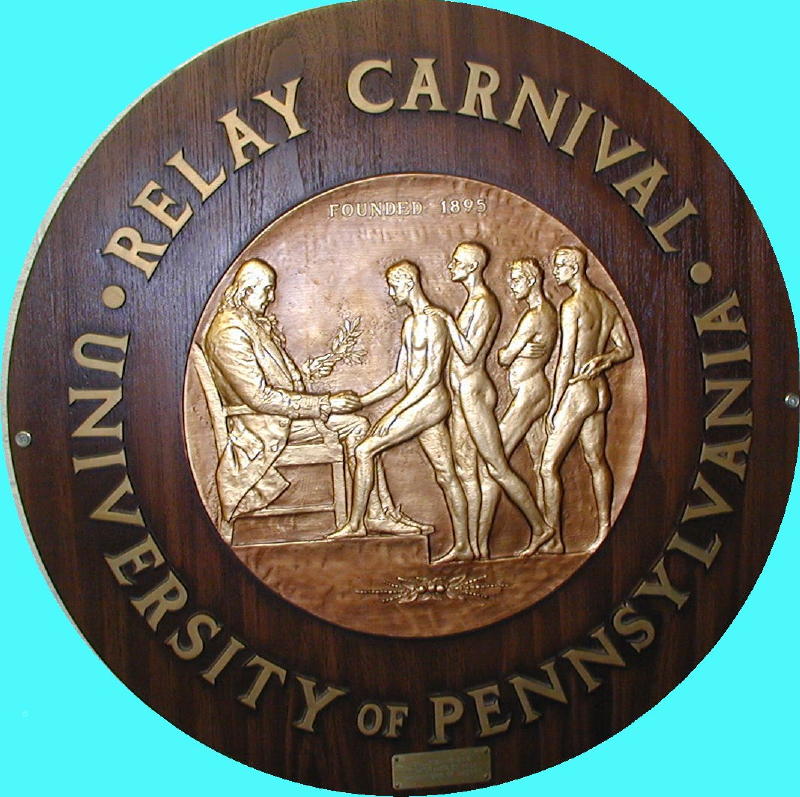





|
|
|
|
January 08, 2004
Reaching out to the past....
Hey, in that last post I didn't mean to drag Caracalla into the American founding! As I keep saying, this blog engages in satire, and occasionally I like to take poetic/historic license.... But I guess, I ought to balance the klassical karma, by dragging the founding fathers of this country back to the classical era of which they were so fond. I have long argued that this country was founded on classical values. And today, I offer some graphic evidence that I am not alone in my belief! Since 1895, Benjamin Franklin has been shown offering olive branches to young athletes in a remarkably accurate imitation of Olympian rites: 
(OK, now who's gonna get serious around here?) UPDATE, IN THE INTEREST OF TOTAL AND ABSOLUTE ACCURACY: Um, I guess I missed some cool memorabilia. And in my haste to snap and post a photo, I failed to research the background of what it was, and so I missed this description of the plaque itself: The design for the Penn Relays plaque and medal was executed by Dr. R. Tait McKenzie in time for the 1925 meet. It shows Benjamin Franklin, founder of the University, seated in a chair modeled from his library chair, holding a laurel sprig in his left hand. He greets four runners, shaking the hand of the first, while the last holds a baton. Posing for the medal were former Penn athletes Larry Brown, Louis Madeira, George Orton and Ted Meredith. At the bottom of the relief is a lightning bolt, symbolic of Franklin's explorations in the nature of electricity.Those were real people??? (Sorry if I invaded anyone's privacy there....) And what about the issue of olive versus laurel? Frankly, I'm not enough of a botanist to know which it is, but I would remind serious classical scholars of the Olympian significance of both: The laurel (Laurus nobilis) contains, in fact, nothing that chemically would be active in inducing such prophetic seizures: it is purely a symbolic commemoration of the entheogens that once figured back in his homelands. Like Athena's olive, the daphne has Hyperborean associations, supposedly first transplanted by Apollo into the Mediterranean world via Thessaly; and like the olive, it is a surrogate for Aminita, the Indo-European sacred mushroom. But like the woinos of Dionysus, it also had Minoan antecedents: for Apollo, these included, as we have already seen, the Dirke Datura and the Lykos wolfsbane. In the assimilation of the two traditions of shamanism, the hysterical shrieks of Apollo's tormented brides became interpreted, not as a message from the chthonic underworld of the Goddess, but a clue to comprehending the mind of Zeus, himself. The fact that the possession was purely spiritual now, without any chemical inducement, made it even more appropriate to the aspirations of Olympian shamanism.Olive and laurel branches were, of course, used together as among this country's founding symbols. The olive and laurel branches are used synonymously in pagan rituals, and both are ancient symbols of victory. And peace, which the ancients recognized as often related to victory in war. Today, however, slogans such as PEACE IS VICTORY! or VICTORY IS PEACE! might be misinterpreted by either "side" depending on context. posted by Eric on 01.08.04 at 11:53 AM |
|
December 2006
WORLD-WIDE CALENDAR
Search the Site
E-mail
Classics To Go
Archives
December 2006
November 2006 October 2006 September 2006 August 2006 July 2006 June 2006 May 2006 April 2006 March 2006 February 2006 January 2006 December 2005 November 2005 October 2005 September 2005 August 2005 July 2005 June 2005 May 2005 April 2005 March 2005 February 2005 January 2005 December 2004 November 2004 October 2004 September 2004 August 2004 July 2004 June 2004 May 2004 April 2004 March 2004 February 2004 January 2004 December 2003 November 2003 October 2003 September 2003 August 2003 July 2003 June 2003 May 2003 May 2002 See more archives here Old (Blogspot) archives
Recent Entries
• Laughing at the failure of discourse?
• Holiday Blogging • The right to be irrational? • I'm cool with the passion fashion • Climate change meltdown at the polls? • If you're wrong, then so is God? • Have a nice day, asshole! • Scarlet "R"? • Consuming power while empowering consumption • Shrinking is growth!
Links
Site Credits
|
|